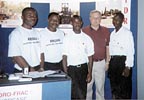
In November of 2000, Charles F. Kyle, owner and president of Kyle Equipment Co., Sterling, Mass., traveled back to Ghana for the West Africa Water Conference. The people attending this conference ranged from local drillers to government officials, and the main focus was how to bring water to the villages. It was here that Mensa Nunyuie, owner of Kingaka Co., informed us of the results of the 12 wells we hydro-fracked and also where we learned what new laws are on the horizon in regards to well construction and abandonment in Ghana.

In a place where water is sparse and money is even harder to come by, it just makes sense to do anything in your power to achieve maxim results on the first attempt. Now the same budget that would provide wells for half a dozen villages can now be used to provide wells for more than a dozen villages.
The trip was not all business, however. At the water conference, Charlie had the opportunity to meet the crew that Jim and I had put through training and present them with certificates of training.
Report Abusive Comment